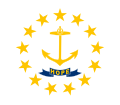 | |
| Use | Civil and state flag |
|---|---|
| Proportion | 29:33 |
| Adopted | November 1, 1897 |
| Design | A gold anchor, surrounded by 13 gold stars, on a field of white. A blue ribbon below the anchor contains the text "hope"; Argent an anchor above a ribbon Azure with the word Hope, all surrounded by thirteen mullets. |
| Fringed Design | |
 | |
| Use | Civil and state flag |
| Proportion | 29:33 |
The state flag of Rhode Island is the official flag of the State of Rhode Island, consisting of a white background and a gold anchor in the center (a symbol for hope) surrounded by thirteen gold stars (for the original Thirteen Colonies and Rhode Island's status as the 13th state to ratify the Constitution). A blue ribbon below the anchor bears the state's motto in gold: "HOPE". The flag is frequently depicted with golden fringe around the edges of the flag, although the fringe is never actually on the flag unless it is used in federal-level displays, much like the national flag.














